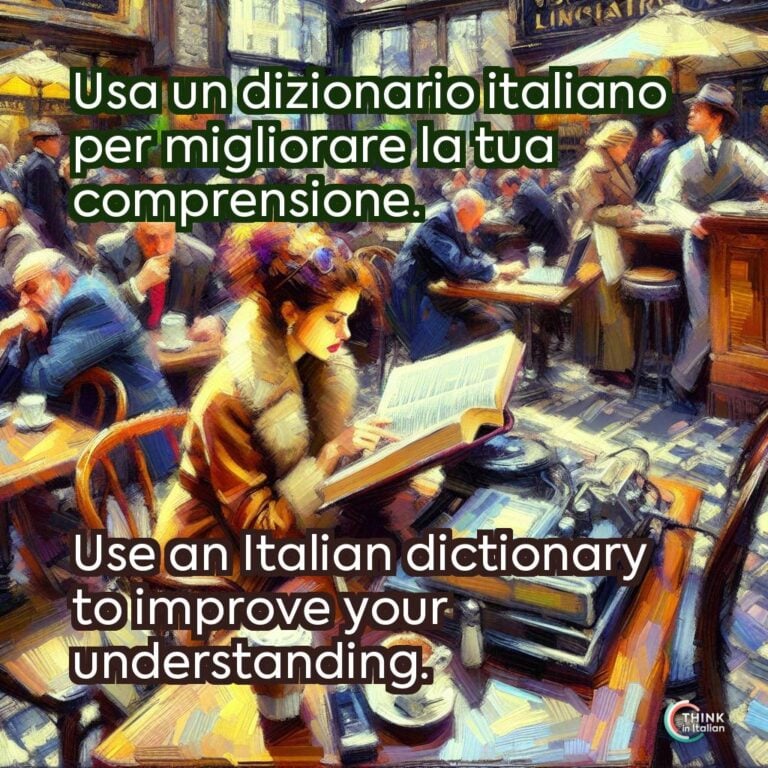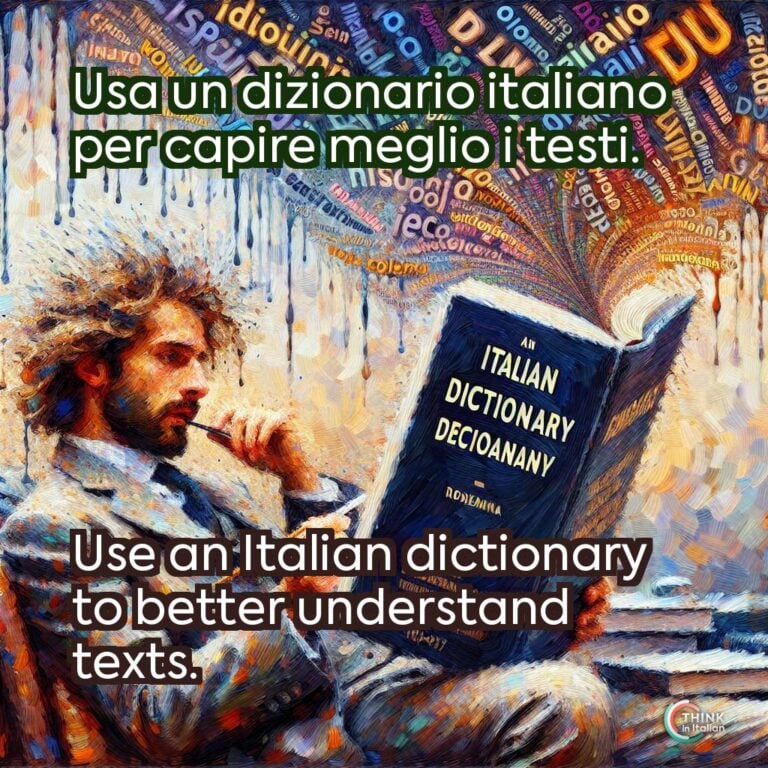Italian Dictionary
Learning Italian can feel like climbing a mountain of unfamiliar words. A good online dictionary can be your best ally, helping you master vocabulary, understand complex sentence structures, and learn pronunciation.
In this comprehensive guide I will explore four different useful Italian tools:
- Italian-Italian dictionaries: powerful tool for language immersion. Instead of translating words, these dictionaries provide definitions in Italian, pushing you to think in the language and develop deeper connections between words and their meanings.
- Bilingual dictionaries: indispensable for beginners and anyone needing quick translations. They provide the bridge between your native language and Italian, offering definitions, sample sentences, and more.
- Contextual dictionaries: they offer real-world examples of how words and phrases are used. They are invaluable for understanding idiomatic expressions, tone, and nuances.
- Translation tools: great for beginners and quick checks but must be used cautiously as they may lack accuracy and nuance.
I will explain what they provide, why they are useful, and what you should use depending on your aim. Whether you’re a beginner or an advanced learner, these tools will enhance your Italian-learning journey.
Italian-Italian Dictionaries
Best Italian-Italian Dictionaries
- Treccani
- The most prestigious Italian dictionary, created by the Treccani Institute.
- Includes etymologies, scientific terms, dialects, and archaic language.
- Ideal for advanced learners due to its comprehensive scope, though it can feel overwhelming.
- La Repubblica’s Grande Dizionario
- Created by Aldo Gabrielli, this dictionary includes:
- 500,000 entries covering definitions, synonyms, antonyms, and etymologies.
- Regional words, slang, foreign terms, and neologisms.
- Perfect for understanding modern Italian.
- Created by Aldo Gabrielli, this dictionary includes:
- Sabatini-Colletti (Il Corriere della Sera)
- Recognized for clarity and usability.
- Great for sentence construction and understanding contextual meanings.
- Sapere.it
- Published by De Agostini, this resource includes bilingual dictionaries for multiple languages.
- Beginner-friendly, making it an excellent stepping stone to monolingual dictionaries.
- Garzanti Linguistica
- Highly user-friendly and suitable for students and professionals alike.
- Devoto-Oli
- Offers nuanced definitions and literary insights, making it ideal for literature enthusiasts.
Why use Italian-Italian Dictionaries?
Italian-Italian dictionaries are invaluable tools for learners who want to immerse themselves in the language and culture, as the definitions they provide are entirely in Italian.
They allow you to think directly in the language rather than relying on translations. You will expand your vocabulary with synonyms, antonyms, and nuanced meanings, and will also be exposed to regional and colloquial terms.
Moreover, these dictionaries delve into etymology, which is something I love reading about and consider very important for language learning.
Etymology reveals the historical evolution of Italian words and connect them to related terms, which helps you appreciate the depth and interconnectedness of the language.
How to use Italian-Italian Dictionaries
To make the most of Italian-Italian dictionaries, my advice is you start by exploring the etymology of words. For instance, learning that canzone (song) originates from Latin cantio helps you connect it to the verb cantare (to sing), reinforcing related vocabulary.
Reading example sentences aloud is another effective strategy, as it allows you to practice using new words in context and improves pronunciation.
If you’re a beginner, start with user-friendly options like Sapere.it, which simplifies entry into monolingual dictionaries. If you’re an advanced, try more complex material like Treccani, which offers detailed definitions and cultural references.
Bilingual Dictionaries
Best Bilingual Dictionaries
- WordReference
- Includes idiomatic expressions, conjugations, and a robust user forum for clarifications.
- Collins Italian-English Dictionary
- Clear, concise, and reliable.
- Offers pronunciation guides and conjugation tables.
- Oxford Italian Dictionary App
- Features 450,000 translations of 300,000 words and phrases.
- Available offline after purchase.
- Built-in Dictionaries (Apple)
- Includes Oxford Paravia Il Dizionario inglese-italiano.
- Allows quick lookups with pronunciation, ideal for Mac users.
Why use Bilingual Dictionaries?
Bilingual dictionaries are essential for learners who are seeking quick and reliable translations between their native language and Italian.
They offer clear and straightforward definitions together with contextual examples. They are particularly helpful in bridging the gap for beginners, allowing them to understand basic Italian vocabulary and phrases without becoming overwhelmed.
Additionally, bilingual dictionaries often include pronunciation guides and verb conjugation tables, giving users practical tools to improve their speaking and writing skills.
How to use Bilingual Dictionaries
To maximize the benefits of bilingual dictionaries, try to integrate them into your daily learning routine: when you look up a word, pay attention to its translation and example sentences provided, as these help clarify usage and context.
For instance, WordReference not only gives the meaning of a word but also highlights idiomatic expressions and conjugations, which are crucial to build fluency.
Take advantage of features like forums, pronunciation audio, and verb tables to deepen your understanding of grammar and proper usage.
For quick and offline access, mobile apps like the Oxford Italian Dictionary can be invaluable, allowing learners to look up words anytime, anywhere.
Contextual Dictionaries
Best Contextual Dictionaries
- Reverso Context
- Provides translations with examples of words and phrases in various contexts.
- Features verb conjugations, audio pronunciation, and the ability to save searches as favorites for flashcard-like practice.
- Excellent for distinguishing between formal and informal usage or spotting rare words.
- Linguee
- Combines dictionary features with bilingual corpora, showing side-by-side translations.
- Useful for technical and professional translations.
Why Use Contextual Dictionaries?
Contextual dictionaries are game-changers for learners who aim at understanding how words and phrases are used in real-life situations. At the end of the day, this is the ultimate goal of learning a language!
Unlike standard dictionaries, these tools provide examples of vocabulary in full sentences, illustrating nuances in tone, register, and idiomatic usage.
By seeing words in context, you will gain a practical understanding of how to naturally use them in conversations and writing. This way, you will avoid the robotic or awkward phrasing that often results from relying solely on direct translations.
How to Use Contextual Dictionaries
Using a contextual dictionary effectively involves looking up not just individual words but also phrases and idioms to see how they are used in different situations.
For example, if you search for piove sul bagnato (it rains on the wet) in Reverso, you will find numerous examples illustrating its use as an ironic expression for compounding misfortune.
Pay attention to sentence structure, word placement, and tone, as these insights are invaluable to develop fluency. Tools which offer side-by-side translations are helpful to choose the appropriate word or phrase for their context.
Translation Toolss
Popular Translation Tools
- Google Translate
- Supports 97 languages and offers pronunciation audio.
- Always double-check its translations, especially for idioms or figurative language.
- DeepL
- A step up from Google Translate, offering more nuanced translations.
- Traduttore.it
- Simple interface translating in 52 languages but lacks pronunciation features.
Why Use Translation Tools?
Translation tools are invaluable for beginners, as they offer quick solutions to understand unfamiliar words or sentences, providing a bridge to navigate the complexities of Italian.
These tools are especially useful when tackling blocks of text or phrases that are beyond your comprehension, allowing you to grasp the general meaning.
I am personally not a big fan of tools like Google Translate or DeepL; I consider them good supplementary resources, as they often lack the nuance required for idiomatic or culturally specific phrases.
Despite these limitations, they are excellent for getting started with basic vocabulary and pronunciation.
How to Use Translation Tools
To make the most of translation tools, start by using them to decode sentences or phrases, but always double-check their accuracy.
For instance, when I use Google Translate, I always reverse the direction of the translation to see if the meaning stays consistent. This helps catch potential errors or inaccuracies.
Tools like DeepL are more nuanced and better suited for complex sentences, as they offer suggestions that are closer to natural usage. Also, take advantage of pronunciation features, which allow you to hear the stress and rhythm of words.
While these tools provide a strong foundation, pairing them with contextual dictionaries or bilingual resources ensures a more comprehensive and accurate understanding of Italian.
Which one Should you Choose?
To truly master Italian, it’s essential to use a combination of tools that cater to different aspects of language learning.
For quick lookups, WordReference is ideal, for deeper insights, Treccani offers unparalleled detail, and for understanding words in context, Reverso is a game-changer.
To learn Italian faster, make it a habit to practice new words in daily conversations and writing, so that you can solidify your grasp of vocabulary through active use.
Additionally, explore cultural insights by using dictionaries that highlight regional slang, dialects, and modern terms which showcase how language evolves.
Whether you’re a beginner or an advanced student, strategically mixing these resources will help you learn Italian more effectively while immersing yourself in its rich linguistic and cultural heritage.






